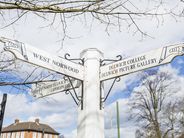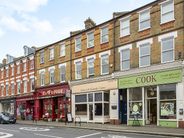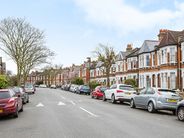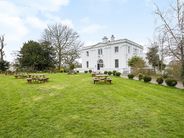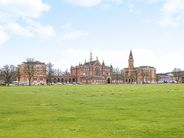
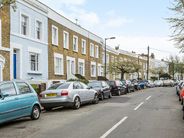
Dulwich
Average sold price last 12 months
£808,527
This area guide is for Dulwich. To read about Dulwich Village, click here. To read about East Dulwich, click here.
What it's all about?
From the gastropubs of East Dulwich and the mansions of Dulwich Village, to the residential calm of West Dulwich, the area collectively known as ‘Dulwich’ comprises of three distinct areas. But what they have in common are hills that shield from the urban bustle of Streatham, Brixton, Camberwell and Peckham, as well as the hilltop towns of Forest Hill and Crystal Palace.
Dulwich Village has long been an upmarket area, largely because of its proximity to Dulwich College – one of the foremost public schools in the country. Life here is peaceful and refined, highlighted by the noise of schoolboys returning home in the afternoon. East Dulwich has more of a pulse to it. Many young families have settled here, and has a plethora of shops, pubs and bars, an art house cinema and a market to cater to their needs. West Dulwich, a mainly residential area west of Dulwich College, has two parades of shops providing the essentials.
Fact file
- Dulwich is first mentioned in history books in 767, when King Edgar granted the land to Earl Aelfheah. The name means ‘the meadow where the dill grows’.
- The tollgate on College Road is the last remaining one in London. It has been in used intermittently since 1789.
- The Kate Macintosh-designed Dawson’s Heights in East Dulwich is the one large postwar housing estate in the area. It was described by the Observer as ‘one of the most remarkable housing developments in the country’.
Architecture and property
Dulwich Village has a diverse range of large Victorian, Edwardian, as well as Arts & Crafts, award-winning 50s architecture, 30s, and 20s properties. The area has a unique London English country village feel, complete with duck pond and Grade-II-listed pubs such as The Crown and Greyhound, known to locals as The Dog. West Dulwich is home to larger Victorian properties, especially on the streets near Dulwich College, while East Dulwich’s Victorian terraces tend to be more compact. Many properties have since undergone loft conversions to accommodate growing families.
For house price information please visit our resource centre.
Going out
Eating: Tucked away off East Dulwich’s Lordship Lane on Zenoria Street is the bustling Brick House Bakery & Cafe. Offering its own sourdough breads, meals range from avocado on toast to boiled eggs and soldiers. Further up Lordship Lane is Franklins and its farm shop next door – try the oysters followed by ox tongue for a hearty meal, then prop up the bar with the locals. Nearby is Yoma Momo, offering contemporary Japanese cuisine. The village pub, the Crown & Greyhound, is a gastro affair with a boutique hotel attached.
Drinking: East Dulwich has plenty of pubs and bars, including cosy and friendly local, East Dulwich Tavern. Over in West Dulwich, The Rosendale offers seasonal food and a range of cocktails to rival East Dulwich, while the Half Moon in Herne Hill is a large regulars’ pub with al-fresco dining areas.
Local highlights
- The Sir John Soane-designed Dulwich Picture Gallery houses old masters and has a lively programme of events, special exhibitions and workshops. It’s also home to an excellent café.
- On Fridays and Saturdays, Northcross Road Market in East Dulwich offers a huge range of food and drink, as well as craft stalls to browse.
- Located in the heart of the Lordship Lane, East Dulwich Picturehouse has three screens showing the latest films.
- East Dulwich is dotted with murals on the ends of buildings, some of them part of the Dulwich Outdoor Gallery. These are created by international street artists giving their responses to old masters housed in Dulwich Picture Gallery.
Green spaces
Dulwich is blessed with lots of open spaces. Dulwich Park has a boating lake, tennis courts, kids’ and adults’ recumbent bicycles for hire, community gardening and a café in the centre offering quality food. Between East Dulwich and Forest Hill is Horniman Gardens. With a museum of stuffed animals and historical curios, it also has a music gallery with 1,300 instruments on display, which can be heard via an interactive touchscreen. Not to mention the aquarium, sound garden, butterfly house, zoo, farmers’ market, and kids’ clubs. Over towards Brixton, Brockwell Park, has a hilltop café, lido, gym and sauna. Sydenham Hill Woods is a wildlife wonderland, with overgrown paths, a folly, ponds, and a disused train line and tunnel that once led to Crystal Palace (now a registered bat roost).
Changing times
With a high percentage of land covered by conservation areas, protected buildings and green space, large-scale new development are unusual. Recent years have seen some smart new apartment and housing blocks in East Dulwich. For example, the architect-designed houses on Hindmans Yard and the luxury Tessa Apartments off Lordship Lane.
Transport
Rail: East Dulwich, North Dulwich, West Dulwich, Herne Hill and Forest Hill stations all offer services into central London, across to neighbouring areas, and further south.
Tube: There are no tubes in the area. The closest is the Victoria line at Brixton and the Northern and Bakerloo lines at Elephant and Castle.
Bus: East Dulwich has the best bus links, with services including the 176 to Tottenham Court Road, 40 to London Bridge, 42 to Liverpool Street, 185 to Victoria and 37 running between Peckham and Putney. Dulwich Village is served by the 3, 37, P4 and P13 buses, while West Dulwich has the 3, 201, 322 and P13 buses.
Road: The South Circular runs east-west through the area and is frequently busy. That aside, roads are fairly quiet, with lots of back routes frequented by locals.
Cycle: Commuting by bike is popular, with TFL’s Quietway 7 route running through Dulwich on its way to Elephant and Castle. Cycle Superhighway 6 will take you up to King’s Cross either via cycle lanes or quieter streets.
Getting away: Gatwick is an hour’s drive or can be reached via train from Victoria or London Bridge, while Heathrow is about a 30 minute train ride away. Eurostar services from St Pancras International can be reached in 21 minutes via the Thameslink service at Herne Hill.
Education
This area first grew because of the quality of education on offer and today is no different. Three of the best public schools in the country are all within 15 minutes’ walk of Dulwich Village. Dulwich College for boys, James Alleyn’s Girl’s School for girls and the co-educational Alleyn’s. Well-regarded state schools include Dulwich Village Infants’ School, Dulwich Hamlet Junior School and The Charter School for secondary school children.
Please see our education resource for more information on schools in this area.
Pop into the nearest KFH branch to talk to our local experts.
Find a property
Looking for a property valuation?
Get an accurate, no-obligation valuation from our local experts.
